In the wonderful world of specialty coffee, the story of coffee cherries transforming to the sublime beverage we all love is a narrative where processing methods whispered in the ears of attentive baristas yield magical results.
Each processing technique—be it natural, washed, or honey—leaves an indelible mark on the bean’s ultimate, potential flavour. In each instance a nuanced approach to extraction is required – one that goes far beyond the simple push of a button.
The Processing Spectrum: A Flavour Cartography
Natural Processing: The Wild Fermentation
Natural processed coffees, where entire coffee cherries are dried intact, represent the most traditional approach to coffee preparation. Originating in Ethiopia, this method creates a flavour profile that is explosively fruity, with intense berry and wine-like notes. For the discerning barista, these beans demand a gentler extraction approach.
Recommended extraction parameters:
- Lower water temperature (92-94°C)
- Longer pre-infusion times
- Reduced total brew time to prevent over-extraction of intense fruit characteristics
Washed Processing: Precision and Clarity
In contrast, washed coffees—where the fruit is removed before drying—offer a flavour profile of crystalline clarity. Popularized in Latin American coffee-producing regions, this method produces beans with pronounced acidity and clean, defined notes.
Optimal extraction strategies:
- Higher water temperature (94-96°C)
- Consistent, even extraction
- Shorter brew cycles that highlight the bean’s inherent brightness
Honey Processing: The Nuanced Middle Ground
Honey processed coffees, sitting between natural and washed methods, retain partial fruit mucilage during drying. This technique, pioneered in Costa Rica, creates a flavour profile that bridges fruity complexity with clean articulation.
Extraction approach:
- Moderate water temperature (93-95°C)
- Graduated pour techniques
- Careful attention to grind size and distribution
Technological Intersections: Equipment and Technique
Modern extraction isn’t merely about method—it’s about understanding how processing influences molecular structure. The Specialty Coffee Association (SCA) research suggests that processing affects not just flavour, but also extraction efficiency and total dissolved solids (TDS).
Grinder Selection
Different processing methods necessitate varying grinder burr types:
- Natural processed coffees: Slightly less uniform grind to accommodate complex particle structures
- Washed coffees: Precision burrs for consistent extraction
- Honey processed coffees: Intermediate burr configurations
Brewing Equipment Considerations
- Pour-over methods like Hario V60 excel with washed coffees
- Immersion brewers like AeroPress complement natural processed beans
- Precision devices like the Decent Espresso machine allow microscopic extraction adjustments
The Sensory Frontier: Tasting and Calibration
Professional cupping protocols, standardized by the Coffee Quality Institute, provide a framework for understanding how processing translates to sensory experience. Each method presents a unique flavour landscape:
- Natural: Intense, wine-like, complex
- Washed: Clean, articulate, bright
- Honey: Balanced, nuanced, complex-yet-clear
Practical Recommendations for Home Baristas
- Invest in a quality burr grinder with multiple setting options
- Experiment with water temperature and pour techniques
- Purchase small quantities to compare processing methods
- Document your observations in a tasting journal
- Attend local cupping sessions to refine your palate
The Continuous Learning Curve
Coffee is a dynamic beverage, a living experience. Each bean is a story of terroir, processing, and human intervention. By understanding these intricate relationships, we rise above being mere consumers and become active participants in a global, sensory experience.I hope you’ve found information here to up your brewing game. I publish regularly here on Bean Indigo and I look forward to you following. The best way is to subscribe to The Coffee Authority Weekly if you haven’t already. Get the information while it’s fresh – like your coffee.



0 Comments